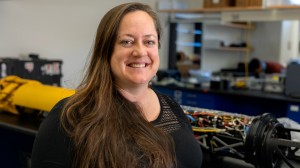The Icefin Instrument Goes Under Glaciers for Research on Melting
From an Article by Linda B. Glaser, Cornell Chronicle, April 13, 2023
Time Magazine has named Britney Schmidt, associate professor of astronomy in the College of Arts and Sciences and Earth and atmospheric sciences in Cornell Engineering, to the 2023 list of the world’s 100 most influential people.
Each year, the Time100 features people who have changed the world, scientific pioneers along with innovators, artists, leaders, titans and icons. Schmidt was recognized for her contributions to climate science, following the recent publication of surprise results about the melting of the imperiled Thwaites Glacier in West Antarctica. The lead author of the companion paper from the project, Peter Davis of the British Antarctic Survey, was also named.
The Thwaites Glacier is roughly the size of Great Britain or Florida and is particularly susceptible to climate and ocean changes. The total collapse of the glacier would contribute an additional 65 centimeters to sea-level rise, whilst also destabilizing surrounding snow and ice.
Schmidt and her team develop robotic tools and instruments and use spacecraft to study planets. By exploring Earth’s ice shelves and glaciers and the oceans beneath them, Schmidt’s team helps to capture the impacts of changing climate on the cryosphere, while understanding analogs for Ocean Worlds like Jupiter’s moon Europa.
Icefin, the underwater, under-ice robotic oceanographer she and her team developed, allowed the team from the International Thwaites Glacier Collaboration to access to environments under ice shelves that had never been directly observed. Shaped like a torpedo, 13 feet long and 10 inches wide, Icefin carries cameras, sonar equipment, speed sensors, water column measuring tools and other devices. The team slips it into open water through a hole.
“Using Icefin, we could see for the first time how and where significant melt under the ice shelf is happening,” Schmidt said. “These new views show us how change is happening under the ice, revealing complex and intricate systems that are responding to climate change and driving sea level rise. Antarctica may feel distant and rugged, but the truth is that it is incredibly vulnerable, and that changes there affect every one of us. Understanding how the planet responds to our actions is critical for stemming the tide of climate change.”
“If crisis is going to unite us, we must find within ourselves that same empathy,” TIME editor in chief and CEO Edward Felsenthal wrote in 2022. “The spectrum of leaders on this list, wielding influence in so many ways, is a reminder that we all have the option to use our power for good.”
Schmidt received a B.S. in physics from the University of Arizona and a Ph.D. in geophysics and space physics from the University of California, Los Angeles. She’s worked on numerous NASA projects, including the Dawn and Europa Clipper missions and the Europa Lander and LUVOIR Space Telescope mission concepts.
>>>>>>>>……………………>>>>>>>>……………………………>>>>>>>>>
See also:”The Female Scientist Who Discovered the Basics of Climate Science — and Was Forgotten By History” ~ By Tyler Santora, Reporter, Audubon Magazine, July 17, 2019
Celebrate Eunice Foote’s 200th birthday ++++ by learning how she predicted the effect of greenhouse gases before the man who gets the credit. Over two hundred years ago, on July 17, 1819, Eunice Foote was born. Thirty-some years later, the amateur climate scientist made the remarkable discovery that when sunlight shines on carbon dioxide in a closed container — our atmosphere, for example — heat builds up inside. She was onto the ”greenhouse effect” of the Earth’s atmosphere.
